Artificial Intelligence (AI) writing is not new. Tech platforms have been using it to finish our sentences in Google Docs; to recommend headlines for ads; and to pull relevant keywords from an infinite number of potential combinations. However, in a way the AI we know today is “new”, especially since Microsoft invested $1 billion in Open AI and then bought exclusive rights to the technology behind Chat GPT 3 in 2020. Fast forward past a marketing and public relations campaign and we strongly feel the conflict that makes us excited and appalled at what AI can do.
When AI Writing Doesn’t Work
I believe that AI writing for book, articles and other long form writing will create a homogenous and boring world. Yes, there are definitely uses for AI, especially in the business world. Who wouldn’t want a technology that could write form letters, contracts, privacy policies, and corporate boiler plates. However, when it comes to writing there is so much that can be missed. Here are four pitfalls of AI that I say should comfort writers.
- Just the facts. How can you rely on an expert’s knowledge and advice if you suspect that AI is doling out the facts? AI does not fact check itself. It’s up to a human to do that.
- Misinformation. Similar to not having the fact, AI can pull from thousands of opinions and false content to come up with something. A user could be embarassed by something they publish that is more myth than reality.
- Innovative storytelling. To Kill a Mockingbird, Little Women, 1984, Catch 22, The Color Purple, and Beloved are all stories that broke barriers. That’s something that writers and creatives do. They ask us to see the world in a different way thereby provoking thought, ideas, and discussion. Does AI have an imagination?
- Personal stories. Many writers start with what they know for their first books. They write memoirs. I suppose AI could write a book based on a person’s life, but that person would have to write it first.
Positive Uses of AI that Save Time
Now that I’ve pointed out why writers need not break their pencils and throw their laptops out the window just yet, I should also mention some areas where AI is likely to help and/or replace some of the things people do for the better.
- Content creation for social media. There is a rule I read in a book on content marketing that says you should be able to create at least ten pieces of content based on one thing. That’s a lot. For marketers writing multiple posts to support press releases or articles, an AI partner could be a time saver.
- Internal marketing departments in big companies. Eventually, you may not need writers to develop annual reports and other marketing collateral that is generated in house. You could feed data into an AI program and have it write the language that is common to these types of documents.
- Writing back ad for book jackets, catalog copy, and other items that summarize a book’s content. You could upload a manuscript into an AI program and ask it to write a summary. The question is, do you trust an open source software to observe copyright laws and protect your story?
- Prompts and ideas. Generative AI may be able to help with writers block. Give ChatGPT a prompt and see what it writes.
A Writing Prompt Result
In this example I asked ChatGPT to give me the first paragraph for a “mystery novel based in Scotland”. I rejected the first try. This is the second.
“The rolling fog blanketed the rugged Scottish Highlands, shrouding the ancient hills and eerie lochs in an ethereal mist. In the heart of this mystic land, a solitary figure moved silently through the gloom, his footsteps echoing on the cobblestone streets of a forgotten village. The wind howled, carrying with it the secrets of centuries past, as if the very whispers of ghosts were woven into the fabric of the night.
Detective Elinor MacGregor had returned to the land of her birth, a place steeped in history and legends. She had come in search of answers, drawn by a cryptic message from her estranged father, a man she hadn’t seen in twenty years. The message was simple but enigmatic: “Return to the Highlands, and you shall find the truth.” Now, as she ventured deeper into the heart of the misty wilderness, she couldn’t help but wonder what truths awaited her in the shadows of her ancestral homeland, and whether she was prepared to face them.”
What do you think? Is it a keeper, or should we ask it to go back to the drawing board?
Writers Lead, AI Follows
From what I’m reading about AI writing, and other disciplines, people are still going to need to drive the bus. So don’t ignore or fear what is happening. (I do recommend paying attention to developments around copyright protections for your work). Learn how to play with it or use it in a business setting so you can take the lead. You are the creative mastermind behind your material You know how to make it as impactful as it can be.
Some articles of interest include our blog on AI and Art, and this one from 2015 about Google’s win in a court case that allowed them to digitize all books.


 DO YOU KNOW WHAT A BOOK PUBLICIST DOES? 3.0
DO YOU KNOW WHAT A BOOK PUBLICIST DOES? 3.0
 I’ve been doing book publicity and marketing for a long time. I keep doing it because I haven’t lost that kernel of idealism and drive that truly believes in the potential for success of a good idea, book, and/or person who has something to contribute to the conversation in the world. Coming up with a strategy that makes these things work and makes my clients happy is immensely gratifying. But (and you knew this was coming), I do raise a caution flag when I get into a conversation about books and bestsellers lists. I hear all kinds of myths about the “right” way to do this and although there can be exceptions to every rule, there are certain realities we all have to know.
I’ve been doing book publicity and marketing for a long time. I keep doing it because I haven’t lost that kernel of idealism and drive that truly believes in the potential for success of a good idea, book, and/or person who has something to contribute to the conversation in the world. Coming up with a strategy that makes these things work and makes my clients happy is immensely gratifying. But (and you knew this was coming), I do raise a caution flag when I get into a conversation about books and bestsellers lists. I hear all kinds of myths about the “right” way to do this and although there can be exceptions to every rule, there are certain realities we all have to know. All of the lists are generated by proprietary algorithms based on quantity, rate of sale, range of sale, date, time, etc. No one, except the people who wrote these things, knows for certain how they work, and I’ve been told that they are tweaked occasionally when it looks like someone out there is trying to be smarter than the system. You can’t buy a thousand copies of your book the day before pub date. You can’t tell a hundred friends to visit your book online or click through to anything. The numbers are based on actual sales, POS (point of sale) whether online or in person at a cash register.
All of the lists are generated by proprietary algorithms based on quantity, rate of sale, range of sale, date, time, etc. No one, except the people who wrote these things, knows for certain how they work, and I’ve been told that they are tweaked occasionally when it looks like someone out there is trying to be smarter than the system. You can’t buy a thousand copies of your book the day before pub date. You can’t tell a hundred friends to visit your book online or click through to anything. The numbers are based on actual sales, POS (point of sale) whether online or in person at a cash register.